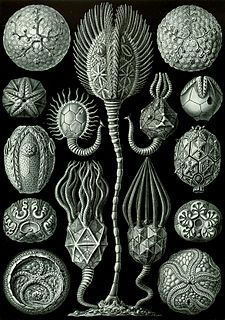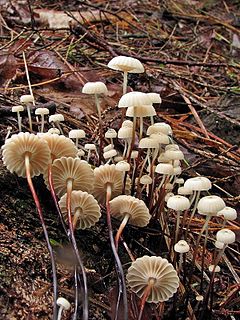
An echinoderm is any member of the phylum Echinodermata of marine animals. The adults are recognizable by their radial symmetry, and include starfish, brittle stars, sea urchins, sand dollars, and sea cucumbers, as well as the sea lilies or "stone lilies". Adult echinoderms are found on the sea bed at every ocean depth, from the intertidal zone to the abyssal zone. The phylum contains about 7,000 living species, making it the second-largest grouping of deuterostomes, after the chordates. Echinoderms are the largest phylum that has no freshwater or terrestrial members.

Crinoids are marine animals that make up the class Crinoidea, one of the classes of the phylum Echinodermata, which also includes the starfish, brittle stars, sea urchins and sea cucumbers. Those crinoids which, in their adult form, are attached to the sea bottom by a stalk are commonly called sea lilies, while the unstalked forms are called feather stars or comatulids, being members of the largest crinoid order, Comatulida.

Starfish or sea stars are star-shaped echinoderms belonging to the class Asteroidea. Common usage frequently finds these names being also applied to ophiuroids, which are correctly referred to as brittle stars or basket stars. Starfish are also known as asteroids due to being in the class Asteroidea. About 1,900 species of starfish occur on the seabed in all the world's oceans, from warm, tropical zones to frigid, polar regions. They are found from the intertidal zone down to abyssal depths, at 6,000 m (20,000 ft) below the surface.

Sea cucumbers are echinoderms from the class Holothuroidea. They are marine animals with a leathery skin and an elongated body containing a single, branched gonad. Sea cucumbers are found on the sea floor worldwide. The number of holothurian species worldwide is about 1,717, with the greatest number being in the Asia-Pacific region. Many of these are gathered for human consumption and some species are cultivated in aquaculture systems. The harvested product is variously referred to as trepang, namako, bêche-de-mer, or balate. Sea cucumbers serve a useful role in the marine ecosystem as they help recycle nutrients, breaking down detritus and other organic matter, after which bacteria can continue the decomposition process.

Brittle stars, serpent stars, or ophiuroids are echinoderms in the class Ophiuroidea, closely related to starfish. They crawl across the sea floor using their flexible arms for locomotion. The ophiuroids generally have five long, slender, whip-like arms which may reach up to 60 cm (24 in) in length on the largest specimens.
Hubert Lyman Clark was an American zoologist. The son of Professor William Smith Clark, he was born at Amherst, Massachusetts, and educated at Amherst College and Johns Hopkins University.

The stylophorans are an extinct, possibly polyphyletic group allied to the Paleozoic Era echinoderms, comprising the prehistoric cornutes and mitrates. It is synonymous with the subphylum Calcichordata. Their unusual appearances have led to a variety of very different reconstructions of their anatomy, how they lived, and their relationships to other organisms.
Himeroconcha is a genus of small air-breathing land snails, terrestrial pulmonate gastropod mollusks in the family Charopidae.
Himeroconcha rotula is a species of gastropod in the Charopidae family. It is endemic to Guam.

Liotella rotula is a species of minute sea snail, a marine gastropod mollusc in the family Skeneidae.

Gathering seafood by hand can be as easy as picking shellfish or kelp up off the beach, or doing some digging for clams or crabs, or perhaps diving under the water for abalone or lobsters.

Cystoidea is a class of extinct crinozoan echinoderms, termed cystoids, that lived attached to the sea floor by stalks. They existed during the Paleozoic Era, in the Middle Ordovician and Silurian Periods, until their extinction in the Devonian Period.

Rotula aquatica is a species of aromatic flowering shrub in the borage family, Boraginaceae. It is a rare rheophyte native to India, where it is a member of the lotic ecosystem of streams.

Vanikoroidea is a superfamily of sea snails, marine gastropod molluscs in the clade Littorinimorpha. The superfamily Eulimoidea is a synonym of Vanikoroidea.
Discula rotula is a species of air-breathing land snail, a terrestrial pulmonate gastropod mollusk in the family Geomitridae, the hairy snails and their allies.

Rotulidae is a family of small sand dollars native to the Atlantic coast of Africa, with 3 genera, with Rotula and Heliophora being extant, the other, Rotuloidea, being extinct since the Pliocene, but all three being found in the fossil record along the Atlantic African coast since the Miocene.

Marasmius rotula is a common species of agaric fungus in the family Marasmiaceae. Widespread in the Northern Hemisphere, it is commonly known variously as the pinwheel mushroom, the pinwheel marasmius, the little wheel, the collared parachute, or the horse hair fungus. The type species of the genus Marasmius, M. rotula was first described scientifically in 1772 by mycologist Giovanni Antonio Scopoli and assigned its current name in 1838 by Elias Fries.

Stereom is a calcium carbonate material that makes up the internal skeletons found in all echinoderms, both living and fossilized forms. It is a sponge-like porous structure which, in a sea urchin may be 50% by volume living cells, and the rest being a matrix of calcite crystals. The size of openings in stereom varies in different species and in different places within the same organism. When an echinoderm becomes a fossil, microscopic examination is used to reveal the structure and such examination is often an important tool to classify the fossil as an echinoderm or related creature.
A rotula is a roll consisting of a long and narrow strip of writing material wound around a wooden axle or rod and written on its interior side.
















